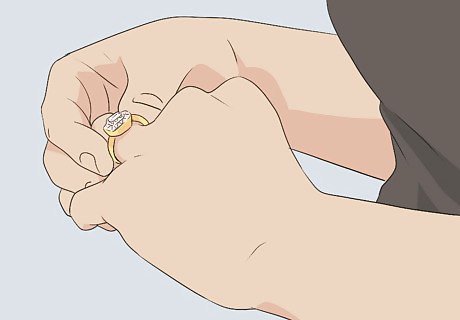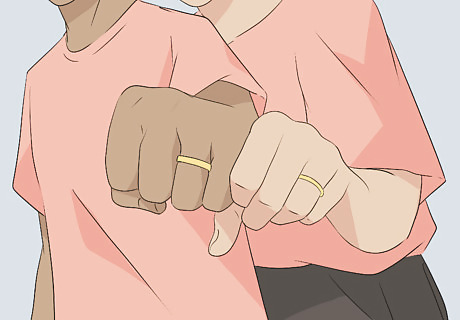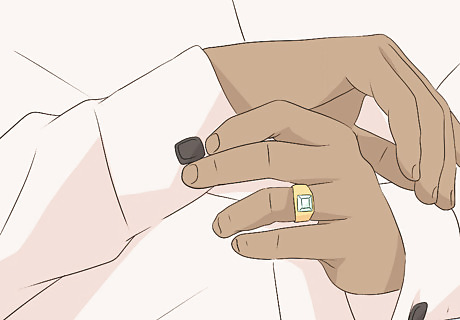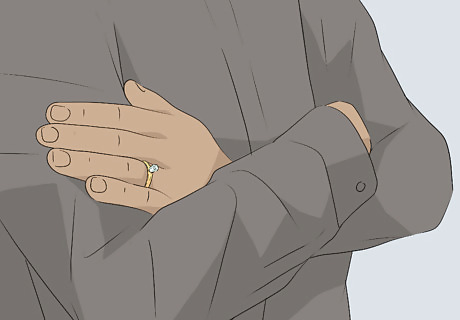
views
- Historically, engagement rings upheld sexist beliefs that women “belonged” to men once they got engaged. As freer members of society, men didn’t need to wear them.
- In the 1900s, men gave engagement rings as “collateral” in case they ended the engagement and damaged their bride-to-be’s reputation.
- Today, engagement rings for men are becoming more popular as gender norms shift. Many choose to wear them as a sign of equality in their relationship.
Why Women Wear Engagement Rings (and Men Don’t)

Men don’t wear engagement rings due to outdated gender roles. Historically, men gave engagement rings to women as a visible sign to others that the woman was “taken” or “belonged” to them—sometimes literally (in many cultures, women were viewed as subservient to men). Since men weren’t seen as a commodity, they didn’t need engagement rings to show they were betrothed, and the tradition persisted for centuries. The ring also served as a kind of collateral in case the husband-to-be backed out of his promise to wed the bride, since this would damage her reputation and chances of getting married in the future. The Romans were among the first to gift rings to their brides-to-be as a sign they were “spoken for” or “off the market” (terms that still get used today metaphorically).

In the early 20th century, women kept engagement rings as “insurance.” By the 1900s in America, the idea of keeping the ring as collateral if the husband-to-be broke things off was codified into law. The “Breach of Promise to Marry” law of 1945 allowed women to sue men who “broke their contract” and keep the expensive diamond ring as compensation. The law was never officially stricken down, but most jurisdictions in the US today have barred it or don’t enforce it in most circumstances. While this law might sound like a good idea, its reasoning is rooted in misogyny. At the time, women were expected to be virgins on their wedding day, but being engaged allowed couples to participate in premarital sex (as an unspoken exception to the rule). If the man ended the engagement, the woman was then societally viewed as less fit for marriage. Engagement rings were still unpopular with men during this time since women didn’t need “collateral.” Men's ability to marry later didn’t depend on whether they’d been engaged or had sex before.

The slogan “A diamond is forever” cemented rings as gifts for women. In 1947, De Beers diamond company used this slogan to link diamonds with the “foreverness” of marriage. They also opened several new mines and featured movie stars in their ads, making diamonds more accessible and desirable to Americans. Men started choosing diamond engagement rings to show they were serious about the “forever” part (and that they wouldn't end the engagement and get sued). De Beers’ marketing success plus the social and legal attitudes toward engagement at the time led to the classic diamond ring many people think of when they picture engagement rings. Ironically, De Beers did run ads for diamond rings for men too, but the idea never really took off. De Beers made diamond engagement rings popular, but they didn’t invent them. Archduke Maximillian of Austria sparked the trend among European nobility when he commissioned one for his fiancée Mary of Burgundy in 1477.
Do guys wear engagement rings today?

More men wear engagement rings now as a symbol of love and equality. As gender norms change and more male celebs sport engagement rings, many couples are more open to both partners wearing them. Some men wear them out of pure love for their partner—a ring representing a forever commitment isn’t inherently gendered, after all! For others, it’s also a sign of equality, marking both partners as equals. Many men in same-sex relationships also sport engagement rings for the same reasons. It’s more common in these relationships since there are no gender dynamics influencing who wears one. Some women also enjoy picking out an engagement ring for their man because it gives them an opportunity to do something kind for them and show their love. In general, men are becoming more comfortable wearing rings and jewelry that were once thought of as “too feminine” for a man to wear.

Studies show that the number of women who propose is slowly growing. About 5% of current marriages were proposed by women. This seems low, but it’s a big increase from the “traditional” days when a woman proposing was unheard of. Attitudes about proposing marriage are changing, too—75% of Americans are OK with women proposing, and half of single women who hope to get married say they’d consider getting down on one knee. This shift in proposal dynamics is another factor that contributes to engagement rings for men becoming more popular. Trends around gender roles in proposal and marriage fluctuate over time. For example, more women chose to keep their maiden name in the 70s than in the 90s because of the social climate at the time. The number of women proposing may also experience ups and downs rather than growing steadily or staying constant.
Popular Engagement Ring Styles for Men

Classic bands A sleek, simple gold or silver band without any stones or decorations is a timeless yet modern look. They never go out of style and resemble many men’s wedding rings, too. Bands come in a variety of metals, colors, and thicknesses to match the wearer’s taste. Simple bands can feature inscriptions on the inside, an inscription or small stone on the outside, or even one rectangular-cut, flat side for visual interest (similar to a signet ring).

Minimalist designs Minimalist jewelry tends to have a more masculine look and feel, making these simple designs great choices for a no-frills kind of guy. Lots of minimalist rings feature a metal band with just one small, square- or rectangular-cut stone (usually a diamond), typically embedded in the band (rather than supported by prongs). Some designs don’t feature any stones, but use clean, simple lines and patterns to create visual interest around the band.

Modern metals While yellow gold and silver will always look classic, other materials are creeping their way into men’s jewelry and engagement rings. White gold, steel, tungsten, titanium, platinum, and cobalt are popular, durable, tasteful metals that can be fashioned into classic bands or minimalist designs. Each metal comes with its pros and cons. For example, platinum is hypoallergenic and both stronger and heavier than gold. However, it’s typically twice as expensive.

Statement rings Who says a man’s engagement ring has to be subtle? Flashy, statement jewelry can feature any metal band in any color or thickness, depending on the wearer’s taste. Instead of classic diamonds, these rings also sport more colorful stones like sapphires, rubies, emeralds, and more (some even combine multiple colors, cuts, and types of gems). These rings are easy to customize to fit the wearer’s specific style, and they’ll always look like a unique gift!















Comments
0 comment